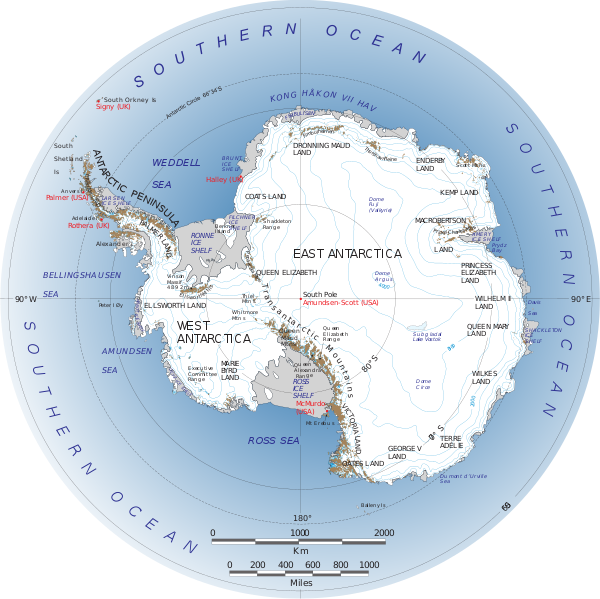Eastern Antarctica
East Antarctica, also called Greater Antarctica, constitutes the majority (two-thirds) of the Antarctic continent, lying on the Indian Ocean side of the continent, separated from West Antarctica by the Transantarctic Mountains, although a minuscule part of Westarctica lies within East Antarctica at the extreme southern section of the claimed "wedge"
Apart from small areas of the coast, East Antarctica is permanently covered by ice. The only terrestrial plant life is lichens, mosses and algae clinging to rocks, and there are a limited range of invertebrates including nematodes, springtails, mites and midges. The coasts are the breeding ground for various seabirds and penguins, and the leopard seal, Weddell seal, crabeater seal and Ross seal breed on the surrounding pack ice in summer.
Location and description
Almost completely covered in thick, permanent ice, East Antarctica comprises Coats Land, Queen Maud Land, Enderby Land, Kemp Land, Mac. Robertson Land, Princess Elizabeth Land, Wilhelm II Land, Queen Mary Land, Wilkes Land, Adélie Land, George V Land, Oates Land and Victoria Land. All but a small portion of this region lies within the Eastern Hemisphere, a fact that has suggested the name. The name has been in existence for more than 90 years, but its greatest use followed the International Geophysical Year (1957–58) and explorations disclosing that the Transantarctic Mountains, provide a useful regional separation of East Antarctica and West Antarctica. The name was approved in the United States by the Advisory Committee on Antarctic Names (US-ACAN) in 1962. East Antarctica is generally higher than West Antarctica, and is considered the coldest place on Earth.
The subglacial Gamburtsev Mountain Range, about the size of the European Alps, in the center of East Antarctica, are believed to have been the nucleation site for the East Antarctic Ice Sheet, just underneath Dome A.
Flora and fauna
Very little of East Antarctica is not covered with ice. The small areas that remain free of ice (Antarctic oasis), including the McMurdo Dry Valleys inland, constitute a tundra-type biodiversity region known as "Maudlandia Antarctic desert", after Queen Maud Land. There are no trees or shrubs, as only very limited plant life can survive here; the flora consists of lichens, moss, and algae that are adapted to the cold and wind, and cling to rocks.
The coasts are home to seabirds, penguins, and seals, which feed in the surrounding ocean, including the emperor penguin, which famously breeds in the cold, dark Antarctic winter.
Seabirds of the coast include southern fulmar, the scavenging southern giant petrel, Cape petrel, snow petrel, Wilson's storm petrel, the large south polar skua, and Antarctic petrel.
